Contents of this page:
1. The present energy system: based
on non-renewable energies
2. Fossil energies: depletion forecast
and environmental problems
3. Nuclear energy: environmental
problems and acceptability
4. The renewable: enormous potential
but difficult to develop
5. World Energy Consumption
6. What future for energy?
1. The present energy system: based on non-renewable
energies
Every year the world population consumes
10.8 billion tonnes of oil equivalent; a quantity contained within
a cube with a dimension of 2.2km. This represents 1.5 tonnes per
inhabitant or 2 kW of continuous use of power (an iron in each hand
turned on continuously would equal this).
(1) A tonne of oil equivalent (TOE)
corresponds to the energy released by the perfect combustion of
a tonne of fuel oil: 1 tonne of oil equivalent = 42 GJ =11,’700
kWh.
The price of energy, which has remained more or
less stable for several decades, is low – the cost of a litre
of fuel in Europe is half the price of a litre of mineral water,
which is an abundant and renewable regional resource.
Another example: a hundred litres of bath water
costs 15 centimes to heat whilst the water costs 25 centimes. Inhabitants
of northern countries, whose energy requirements are easily met,
see no reason to curb unnecessary consumption. For the citizen,
unaware of the reality of energy problems, the impression given
is that of great abundance of energy, when in truth, almost 85%
of the resources used are not renewable.
This preliminary observation should be relativized
by the huge inequalities between individuals’ consumption
across continents. The average American will consume an equivalent
of 8 tonnes of fuel per year compared to 0.3 for a citizen in some
African or Asian countries. Here, the concern is with average energy
consumption rather than a comparison between 5% of the riches of
the planet with 25% of the poorest – below the poverty line.
(There are an estimated 2 billion individuals living without electricity).
Division of Primary Energy Sources are as follows:
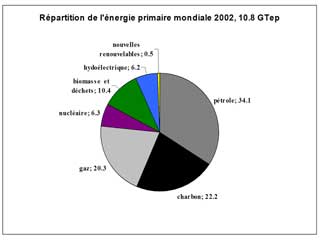
Division of Primary World Energy (2002)
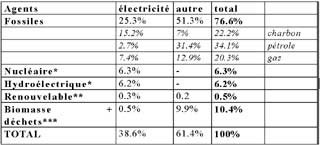
Division of Primary World Energy (2002)
* nuclear and hydroelectricity refer to the primary
heat equivalent of the electricity produced by a fossil plant with
average thermal efficiency of 33%. The multiplication factor is
3, corresponding to efficiency of conversion of heat into electricity
– 40% and of combustion – 80%
** geothermal, windmill…
***biomass figures – the biomass essential in many southern
countries – are often excluded from official statistics which
only consider energy resources linked to financial exchanges that
are easily accounted for.
Some comments on these figures :
• Fossil fuels supply about 80% of world energy
• Nuclear power plays a surprisingly small part in the supplying
of world energy
• For the time being hydroelectricity is the only 100% renewable
resource which markedly contributes to human needs – the biomass
often being managed as a non-renewable resource (problem of desertification)
• In looking at final energy (energy consumed) there is a
decrease from about 40% to 20%, due to production losses.
2. Fossil energies: depletion forecast and
environmental problems
Values of non-renewable energy reserves
and resources should be treated with care: they can vary according
to sources for objective reasons (scientific disagreement, problems
of definition) or for more subjective reasons associated with geopolitics.
Resources and reserves should be considered separately and attention
given to accuracy and reliability of figures.
First, distinction should be made between what
is referred to as ‘resources’ and what is termed ‘proven
reserves’. Resources are theoretical quantities estimated
from physical considerations without technical or economic constraint.
Proven reserves are quantities located with high probability (90%
or more), of susceptibility of being technically and economically
exploited.
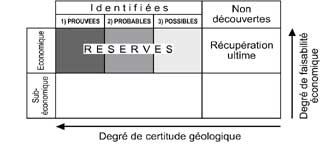
See Professor Gorin’s table (Geneva
University)
1) proved : P90 : 90% probability
2) probable : P50 : 50% probability
3) possible : P10 : 10% probability
Since the industrial revolution, roughly 1/5 of
a total of oil resources have been consumed (between 1/4 and 1/6
according to experts). By the second half of this century, the last
conventional oilfields will be concentrated in the Middle East –
gas in Russia and the Middle East.
It will then be necessary to exploit non-conventional
sources (oil sands and extra-heavy bituminous crude), but what will
this cost both economically and ecologically? There is no trouble
imagining the international tensions that this may give rise to.
The situation for natural gas is analogous; coal
reserves remaining plentiful.
Urban pollution
This concerns the famous ‘smog’, which
poisons the populations of cities in all seasons.
• In winter, temperature inversions associated
with emissions from heating and motor vehicles cause high level
air pollution (NOx, SO2, CO, unburnt residues)
• In summer, the rays of the sun, heat and
nitrogen oxides produced by motor vehicles cause high levels of
tropospheric ozone
Problems raised by air pollution in cities are
highly complex and affect a range of disciplines: engineering sciences,
architecture, town planning, national and regional development,
economy, social sciences, law, and politics. These (problems) become
even more acute in cities situated in the south, where there is
an accumulation of anarchic development, old and polluting modes
of transport, warm, sunny climates and lack of finance.
The greenhouse effect
This, to be more precise, is the amplification
of the natural ‘greenhouse’ effect, which trapping infrared
rays already increases the temperature of the globe by about 30%
thus making it habitable. Some gases resulting from human activity
and mainly from production or use of energy amplify this natural
process.
Whilst the reality of the greenhouse effect is
not doubted, its true impact on global temperatures is very difficult
to gauge. Precautions should thus be taken – greenhouse gases
should be limited from now on.
3. Nuclear energy: environmental problems and
acceptability
Reserves
Care should be taken with figures relating to uranium
reserves for the following reasons:
• Deposits are very diluted (< 1%) and
conditions of their formation ill-defined
• Uranium is a highly strategic raw material
– data on its reserves often considered as a military secret
Uranium reserves are not a problem before the XX11
century at present rate of exploitation.
Nuclear energy is characterised by its complexity
and high technology.
Radioactive pollution
The accident at Chernobyl clearly demonstrated
that nuclear energy use, even with today’s (state of the art)
technology, is not without global environmental risk.
What are the obstacles for nuclear
energy today?
According to D. Finon’s article in book Cuepe
EES No.2, several constraints have to be considered in relation
to nuclear energy:
• Social acceptability. The specificity of
nuclear risk – low accident probability but with serious consequence,
problems of long term waste management over several generations
and risk of military proliferation – make the formation of
collective preference difficult and scientific consensus impossible.
• Economic constraints. There are three:
1. Inadequacy of nuclear technology within the
competitive market of the electricity industries: nuclear plants
have to be large (built in one stage: 1000 MW) to be economically
viable, although once built they are inexpensive to run (little
fuel needed) large initial investment is required, fear of long/medium
term uncertainty such as tightening of legislation and cost of upgrading
old plants, social rejection due to major world accident…
2. Competition of combined-cycle gas turbine (electricity
production with a closed steam turbine and an open-cycle gas turbine
– natural gas combustion)
3. Financial constraint in developing countries:
international
organisations have difficulty finding the funding necessary, local
stakeholders/governments do not have sufficient economic resources
and prefer more progressive options.
4. The renewable: enormous potential but difficult
to develop
Humankind has not waited until the
end of this century to heat, move and produce using solar energy,
which for a long time was the only available energy resource. However,
industrial civilisation has not been able to make the most of this
abundant, natural but capricious energy source. In order to understand
the future role (of renewable energies), six important points should
be explored:
Study in depth: Spécificités
des énergies renouvelables (pdf) , Bernard
Lachal, Université de Genève
1. The share of renewable energies used
to cover human needs attained its minimum but now has a tendency
to increaseLa part des énergies renouvelables.

2. Use of the biomass
is still a mainstay for renewable energies, mainly in the south,
However, man’s predatory attitude towards it must be changed
in order for this to truly qualify as ‘renewable’. ‘Reasonable’
exploitation of the forest, development of efficient energy cultures,
which would not compete with food production are some of the challenges
to be faced for the full and lasting exploitation of the important
potential offered by this option, which would be revolutionary in
the relationship between man and nature.
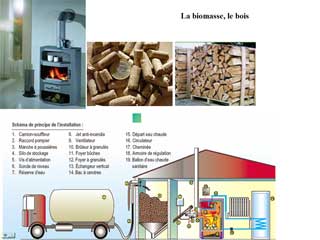
3. Ancient methods, dating
from antiquity (hydraulic and wind) have fully benefited
from technical advances (turbines, aeronautics) and are technologies
that can still be relied upon. Mills have completely disappeared
but the force of water is used today to produce electricity, which
can be easily transported and distributed thanks to the development
of electricity networks. Exploited potential of Hydroelectricity
is variable across continents: high (in number) in Europe (80%)
medium in North America (50%) and low in Latin America, Africa and
Asia (<30%), which possess enormous potential. The impact that
huge dams can have on the environment like the Aswan High Dam in
Egypt or the future dam of the Three Gorges in China can be great
- although not necessarily problematic (see the use of hydraulic
potential in the alpine regions for example). The setting-up of
smaller installations (even ‘micro’ hydro of a few kW)
is more favourable from this point of view.
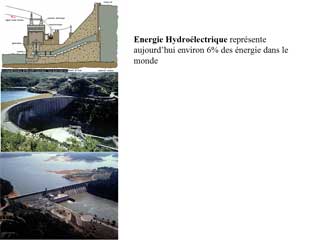
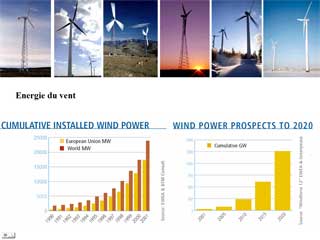
4. In the longer term,
only intensive transformation directly from solar rays
has the quantitative capacity to substitute fossil fuels, and that
only on condition that energy demands stabilise through more rational
use. Solar rays represent a resource 10,000 times superior to present
world energy consumption, and are spread fairly evenly over the
surface of the earth in comparison to other resources.
Space needed for solar transformers is not so great compared to
other transformers, if the whole process from extraction to waste
treatment is taken into account.

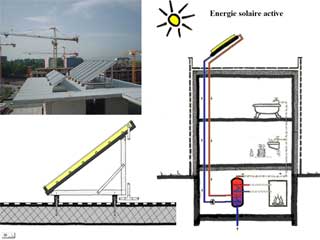
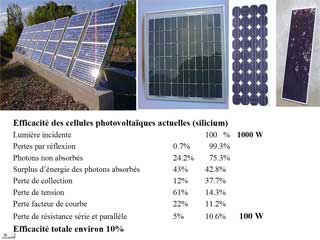
Renewable energies used today are the most extensive
and are connected to other fundamental natural cycles (carbon and
water for forests and dams). To produce the same quantity of electricity
as the Aswan Dam (in Nile Valley) today, a thermal solar station
covering a surface of about 20km2 (only a small portion of the water
held at present) would be sufficient and economic and environmental
costs certainly inferior.
Intensive exploitation (solar but also wind) is
undeniably advantageous and may be carried out in areas unsuitable
for other activities (deserts and seas …)Out of different
possibilities, photovoltaic seems the best long term option. It
is also the only option that is truly new and undergoing full evolution
in a field where potential for new technology is vast. Possibilities
of rapid development are real, but prone to problems of economic
constraint. Penetration of this technology in our latitudes is limited
by the problem of storing the electricity from one season to another.
The hydrogen option has on this account a more promising future
but its development is under discussion as it is dependent on heavy,
new infrastructures.
5. There should be no opposition
between centralised and decentralised production which
should be complimentary. A conflicting point of view is often given.
Would it not be preferable to forgo an ideological stance and seize
all opportunities to develop renewable energies: the former supplying
kWh to a main grid while the latter supplies services in isolated
areas or backup to an existing grid.
There are an estimated 2 billion
people in the world not yet connected to an electricity network,
most of whom will not be in the near future. These populations’
needs, can be met (lighting, radio…) by decentralised individual
or collective ‘mini’solar plants: this represents an
important market both for these populations and photovoltaic stakeholders.
6. The pursuit of the development
of renewable energies depends on long
term vision and participative action, as demonstrated by the success
of ‘wind power’.
Public/governmental powers and large electricity
companies at present undergoing full evolution hold a crucial role
(globalisation of the economy, weakening roles of the state, liberalisation
of electricity/gas markets). Particular care will need to be taken
concerning legislation put in place for free energy markets, so
that development of renewable energies is taken into account.
5. World Energy Consumption
1) Present energy consumption:
apparent abundance but with profound imbalances.
Each year, the population consumes about 10 billion
tonnes of oil equivalent – the geographic distribution of
which, is as follows:
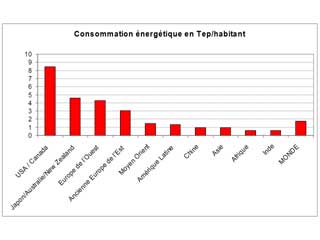
World Energy Consumption per inhabitant and
for different regions (2000)

World Energy Consumption per inhabitant and
for different regions (2000)
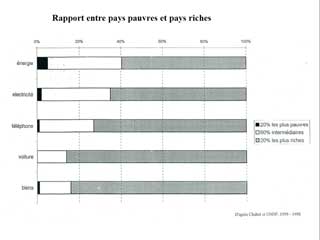
R elationship between poor and rich countries
2) Different energy uses: the
importance of the building industry
In developed countries a tendency towards equal
distribution between the three usual energy uses is observed: housing/agriculture,
transport and industry. In other countries this distribution varies
greatly according to the social structure of the country, level
of urbanisation, kind of industry … in Switzerland distribution
is as follows:
- Industry/Services/Agriculture: 38%
- Transport: 33%
- Household: 29%
Industry
Energy needs per unit of merchandise/goods produced
diminish over time due to improvements in technology and environmental
pressures. Energy contained in materials, objects … is termed
‘grey energy’.
Globally, energy intensity (the quantity of energy
per franc of GDP) follows an evolutionary pattern over time ‘in
the shape of a bell’: at the beginning, basic industrialisation
requires much energy for initial production and a necessity to increase
energy investment in order to increase this. Once this stage is
passed, production requires less energy and energy intensity decreases.
An essential question is the possibility for developing countries
to bypass the first and very intensive phase in energy use and have
direct access to lower energy intensity ‘leap frogging’.
Transport
The transport sector is the one that is increasing
fastest, be it private/individual motor vehicles, goods transportation
by lorry or air transport. In Switzerland, contribution for transport
has increased from 27% in 1980 to 31% in 1996, corresponding to
an increase in relative terms of twice that of total energy consumption.
It is necessary to highlight the importance of
national and regional development in people’s choice of transport
as shown in the following figure:
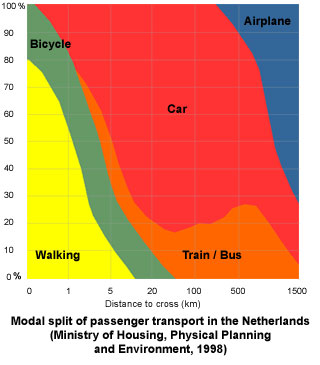
For example, it can be seen on this graph - valid
for Holland, that for distances less than 500 m, 20% of the population
use the bicycle; others go on foot. For journeys of more than 3
km, most people use modes of transport which use energy (train,
bus, car and plane).
Buildings
Five points should be highlighted:
1. The thermal needs of buildings
represent an important stake in rational energy use. In Geneva,
thermal energy demands for buildings (heating and hot water) represent:
• More than 50% of energy
consumption in Geneva
• About 42% of total energy
consumed in Switzerland
• About 33% world consumption
2. The evolution of corresponding
energy consumption is characterised by a relative stability in Switzerland
as in neighbouring countries in spite of a large increase of surface.
3. Further/new needs appear or will
appear in Mediterranean countries (at present with little heating)
or in the south (hot water and plumbing)
4. Possible ways of controlling
energy use are numerous, but slow to be put into place.
5. The case of air conditioning
is far more complex and also a cause for concern.
Study in depth: Les
besoins d'énergie thermiques des bâtiments (pdf)
Bernard Lachal, Université de Genève
6. What future for energy?
Energy scenarios over a long term
(2050-2100) are subject to numerous studies. Let us remember that
these are prospective exercises, which do not aim to predict the
future but to imagine and explore possible futures.
The main difference between scenarios and what
can be found in papers on the subject lies in the total of energy
consumed. This could vary from a single to a double figure or from
a single to a quadruple figure in 2050. Scenarios of low consumption
are based on rigorous policies and scenarios of high consumption
are often scenarios said to be ‘business as usual’.
The possibility of truly limiting energy consumption
is an intensely controversial subject: everyone agrees in thinking
that this is technically possible and often economically viable.
Conservatism and resistance to change are explanatory factors often
given. This leads some to say that only a big crisis could change
mentalities.
Looking towards 2050, and in spite of their differences,
various scenarios agree on certain points:
• Fossil fuels (oil, gas, coal) will continue
to be much used – the total quantity used is obviously minimal
in scenarios economising energy.
• Nuclear figures will not exceed 15%, its contribution
being imagined as identical to the present (5-10%)
• Contribution of renewable energies differs
strongly (20 to 50%) more prominent in scenarios of low consumption.
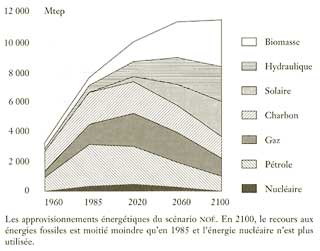
Here energy consumption is contained, thanks to
vigorous economy of energy (lowering in northern countries, increasing
in those of the south bringing them to a similar level). In these
conditions, it is possible to see the important role of renewable
energies. Scenario NOE, above - see example of the comparison of
three scenarios:
Study in depth: Le
système énergétque mondial, 3 scénarios
long terme (pdf) Bernard Lachal, Université
de Genève
The conclusion is that energy problems will be less difficult to
resolve once energy consumption is limited. In view of the quantities
of energy used for the construction and use of buildings, it is
of utmost importance to integrate as many imperatives of energy
economy as possible, be it for new or renovation of old. The architect
has an important and influential role to play within this framework.
|
![]()